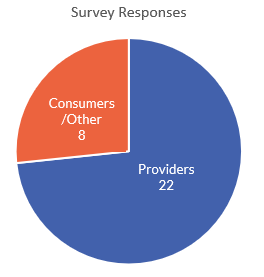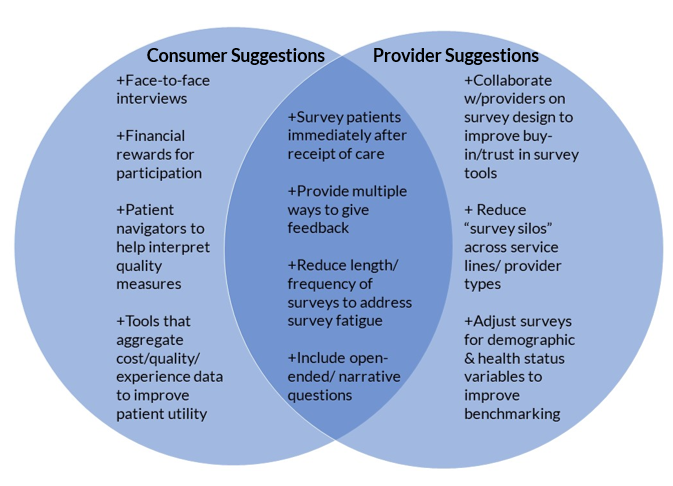23 May Patient Experience Measurement Survey Brief
Download the Survey Brief
The Health Care Transformation Task Force conducted a survey of health care provider and patient/consumer organizations to assess the current state of patient experience measurement. The survey asked respondents to identify the aspects of measurement they found valuable, describe the gaps in measurement and challenges to greater utilization, and recommend suggestions for improving the utility of patient experience measurement. The surveyed pool included twenty-two provider organizations and eight consumer advocates/other organizations.
Results
Survey data revealed a common set of concerns regarding patient experience measurement as well as common suggestions for improvement. Ultimately, the data suggests that the current approach to patient experience measurement is not adequately meeting the needs of patients or providers, suggesting a ripe area of opportunity for further work to improve the utility of measurement to inform quality improvement efforts and the provision of patient-centered care. 
Methods
Surveying was conducted using two separate online surveys, one designed for providers and caregiving organizations, and the other for consumer advocates/other organizations (e.g. payers, purchasers, foundations, etc.). The surveys were created with the direction, expertise, and input of the Task Force’s Patient-Centered Priorities Work Group. The surveys were distributed to the Task Force members as well as recommended organizations outside the membership.
Analysis
Challenges
Eighty-seven percent of provider respondents noted that they use patient experience data to inform continuous quality improvement strategies. Still, they identified several common challenges with current measurement methodology, including: difficulty contacting patients; low response rates/lengthy surveys; cost of data collection; low provider engagement/responsiveness to results; provider perceptions regarding the validity of the data including the perception that data mainly reflects unsatisfied patients and/or non-clinical issues; and lack of standardization in measurement tools and the resulting difficulty of comparing performance across practices.
Consumer respondents highlighted some examples of patient experience measurement best practices, but also identified various challenges. Perhaps most notably, patients largely do not see utility in or use patient experience measurement data to inform care decisions. Other challenges precluding patients’ ability to meaningfully participate in patient experience measurement included: lack of resources and time; focus on a daily living challenges; perceptions that the results won’t actually impact future care or lead to changes; burden of mailing back the survey; language and literacy barriers; and challenges with collecting patient experience data related to mental health or other more sensitive conditions.
Suggestions for Improvement
While provider and consumer respondents each had unique suggestions for improving patient experience measurement, they also had a set of overlapping suggestions. The Venn Diagram below details these findings:
Conclusion
The survey results highlight the need to modernize patient experience measurement and increase its utility for all health care stakeholders, especially for patients who are tasked with navigating an increasingly complex and costly system. The Health Care Transformation Task Force views patient experience measurement as a vital component of the health systems move to patient centered value-based care and will continue to work to identify multi-stakeholder consensus-based strategies to improve patient experience measurement.
